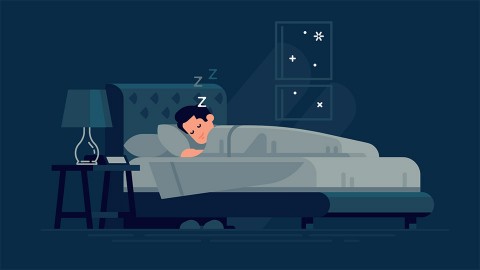The ability to learn novel physical movements — similar to those taught in rehabilitation for people with stroke — can be improved by reactivating specific memories of the new task during sleep, reports a new Northwestern University study.
This is the first study to show learning a novel physical action can be enhanced during sleep. It was published Oct. 18 in the Journal of Neuroscience.
“The findings suggest that this sleep-based stimulation could potentially accelerate physical rehabilitation in stroke survivors as well as any neurological disorder that needs motor rehabilitation,” said co-senior author Dr. Marc Slutzky, professor of neurology at Northwestern University Feinberg School of Medicine, a Northwestern Medicine neurologist and a Shirley Ryan AbilityLab research scientist.
Sleep’s role in learning: more important than you realize
The study also deepens the understanding of sleep’s role in learning.
“Our results demonstrate sleep’s importance for learning to perform novel actions,” said co-senior author Ken Paller, a professor of psychology and director of the Cognitive Neuroscience Program in the Weinberg College of Arts and Sciences at Northwestern. “The conclusions of our study may apply more widely to skills that people strive to acquire, such as learning a new dance move, a new athletic move or a fine-motor skill like manipulating a scalpel.”
“Most people understand intentional practice aids learning,” Paller said. “We propose in addition to this practice, brain processing that escapes our awareness, such as during sleep, contributes in important ways to learning skills and acquiring new knowledge.”
It’s tricky to isolate muscles
Northwestern scientists studied healthy individuals as they learned to perform novel actions with specific arm muscles in which they had to learn to contract individual muscles and pairs of muscles. Study participants learned the novel muscle movements via a video game-led training device called a myoelectric computer interface (MyoCI). Slutzky and his team invented the MyoCI as a treatment for people with impaired arm movement after stroke. In that scenario, individuals with stroke must learn to isolate arm muscles to regain the ability to accomplish tasks such as extending their arm forward with a straight elbow.
Many stroke survivors can’t do this seemingly simple movement because their muscles act against each other in abnormal ways, called abnormal co-activation or abnormal coupling. Thus, learning to isolate muscle contractions to perform tasks can help their rehabilitation. Although study participants had no movement impairments, isolating arm muscle contractions is challenging even for healthy individuals.
Softly influencing the brain during sleep
In this study, student participants learned to use the MyoCI in a single session, and each new movement being taught was coupled with a different sound for a total of 16 sounds and movements.
Researchers then influenced the sleeping brain by presenting sounds associated with a subset of those novel actions to isolate muscles. When they reached slow-wave sleep, which is the deepest stage of non-REM sleep (as opposed to REM, or Rapid Eye Movement sleep), lead author Larry Cheng, a Ph.D. student in psychology, presented eight of the 16 sounds, one every five seconds. The hypothesis was the eight sounds (cues) would reactivate the memories of eight of the actions the participant had learned, and thereby improve the learning of those specific actions. The sounds presented to them during sleep were played softly, so sleep was not disrupted.
It worked!
When people woke up, they performed the actions again, and the performance on the eight cued actions was quicker and more efficient than performance of the actions that were not cued during sleep.
The method of Targeted Memory Reactivation scientists employed has been used before with many types of learning, but none of the prior studies focused on a task of learning new actions. The new results expand the understanding of the types of learning that can be improved when a practice session is followed by a period of sleep (as happens every night for most people).
“Our study did not simply look to see if performance improves after sleep,” Cheng said. “Rather, we systematically altered which memories were reactivated during sleep, using subtle sound presentations. This is a powerful method for understanding sleep because we systematically alter what happens during sleep.”
The Paller and Slutzky labs have since collaborated to launch a clinical trial with chronic stroke survivors. The goal is to see if the nightly memory reactivation of learning new movements, as an adjunct to MyoCI therapy sessions during the day, improves their ability to use their arms.
“With this NIH-funded project, we hope to determine whether rehab outcomes can be improved by taking special advantage of the downtime of nightly sleep,” Paller said.

